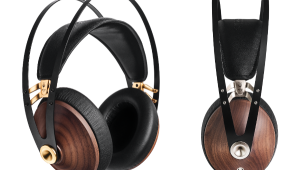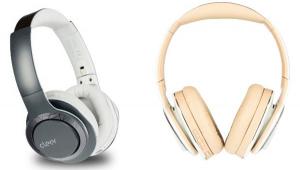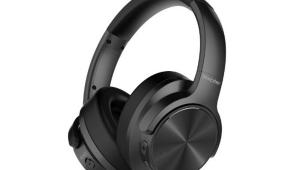Review: Velodyne vTrue Studio Headphones

As Brent Butterworth reminded everyone earlier in the week, subwoofer specialists Velodyne impressed us quite a bit last year with their first headphone effort, the in-ear vPulse. That headphone - bass-forward but with good performance over the rest of the audio spectrum - made it clear that the company's headphone development effort was more than just bandwagon jumping. Now Velodyne has followed up with a pair of traditional models: the vFree ($299), a portable Bluetooth model that Brent told you about the other day, and the luxurious, full-sized vTrue ($399).
Getting Comfortable
While Velodyne hasn't exactly shied away from spotlight with previous designs (the electric blue finish of the well-regarded vPulse made it as immediately identifiable as anything from Beats), these things make even Monster's Diamond Tears look almost sedate. The huge brushed-metal surfaces are going to have passersby using your headphones to check their makeup or pick spinach out of their teeth. It's certainly slick, though not quite gaudy, and not as explicitly flashy as, say, some V-Moda designs, but it's seriously noticeable. The leather appointments are classy, but somewhat out of place for something you might wear around town or for business travel - reinforcing the vTrue's positioning as a home-listening 'phone, and in that context the finish does lend a little gravitas to the setup.
But given that, the pad arrangement struck me as a bit odd - despite the size of the aluminum cups, the vTrue's pads are actually very small in circumference, and equally shallow - despite its size, this headphone is (much like its sibling, the folding, wireless vFree) really an on-ear rather than an over-the-ear phone. It's as if the designers couldn't decide here and decided to go for something along the lines of the ear-pillow approach taken by Bowers+Wilkins, but wanted it look like an over-the-ear. There's even a second cable (by the way, the attachment uses a Y-shaped yoke, with L/R connections clearly indicated and color coded) with an iOS controller and mic-pod in the box, further heightening the confusion (though as with the vFree, there's only a drawstring bag included, rather than a substantial carrying case).
While the smallish pads aren't uncomfortable (like the B+Ws, they're soft enough that they don't exert undue pressure on your pinnae), isolation is limited, and for a headphone that's clearly bass-forward in voicing the arrangement doesn't seem to make as much sense as would a design that sealed a bit better. I had some trouble getting the vTrue into a bass-friendly position, but I have smallish earlobes - the sorta-on-ear, sorta-over-ear configuration left me a bit stuck, while I could see the vTrue working out just fine as a true on-ear for those with larger ears. Still, even if the fit was never perfect for me, the vTrue was comfortable enough to wear for long periods, so the pad design is far from being "bad" - but you should absolutely try before you buy.
I couldn't help but think that the vTrue could have been slimmed down a bit, or even made portable - there's really no reason for it to be as bulky as it is given the relatively minuscule pads. A hinge mechanism would have been really nice to see here as well, since the attention-getting looks might appeal to those interested in, well, attention getting - but the big vTrue's unlikely to fit in an average attention getter's bag.
But that'd be a rather different headphone. So what about the vTrue's sound?
Performance
As you might expect from Velodyne, once I got them seated correctly these things dished out the low end very effectively. Bass is clean, controlled, and powerful - so present, that my first impression of the vTrue was that it as rather dull sounding. After wearing the vTrues for a while, switching back to the V-Moda M100 (itself no slouch in the bass department) is like putting on Grados. That's a lot of bass!
But as I spent more time with the Velodynes, and managed to get a little better fit and positioning, I was struck by how little the dominating low end interfered with the midrange. Too many headphones I've heard over the past year or two have sacrificed midrange clarity to get a little upper-bass punch - that's definitely not the case here.
Even with something dense - like "Ode to Sad Disco" fro the Mark Lanegan Band's recent Blues Funeral - the bottom-heavy synths and Lanegan's textured baritone are done equal justice. (His voice tends to suffer on 'phones whose low-end punch comes at the expense of a resonant peak in the upper bass, and thus do a poorer job of keeping the midrange out of the way of the bass.) Similarly, PJ Harvey's vocal (and autoharp) are cleanly reproduced above the booming orchestral percussion of "On Battleship Hill" (from Let England Shake). The low end got a little murky, but everything above escaped unscathed; even the gentle brushwork.
On the bass-dominated material that's clearly in the vTrue's wheelhouse, it performs admirably, so long as I was careful to sit still and concentrate on keeping the headphones in a good position on my head - L. Shankar's extended violin and Bill Laswell's dubby baseline both had good character on "Mantra" (from Material's Hallucination Engine), with Laswell's light touch and lowpass-filtered tone clearly evident. Things got a little woolier with heavy rock - the double kicks and multiple low-tuned guitars of Meshuggah's I got a bit cluttered for my taste, though I really prefer either multi-driver in-ears or an open-back phone with crispier highs for such listening in any case.
The vTrue's obviously a capable and versatile phone. Brent Butterworth also gave it a long listen, and concurred. Checking out Steely Dan's "Aja," a favorite test track, Brent found the miss and highs "detailed and fairly natural." The vTrue "ain't the HE-500…but it ain't bad." On the other hand, Brent felt that on that tune he bass didn't live up to that standard, and was more in line with what he'd expect from a "casual headphone he'd use on the subway, with an excessively punchy, kinda high-Q sound." And bass aside, he loved the vTrue's reproduction of Toto's "Rosanna." "It's amazing," Brent exclaimed, "that they can pump up the bass like this without obscuring the mids and highs at all."
Brent was able to get a better sense of space out of the vTrue than I was, probably given the better fit he seemed to have. Still, turning to acoustic jazz and rock music, he encountered a little top-end softness. Listening to Charles Lloyd's "Prometheus" (from Rabo de Nube), he loved the imaging of the piano, though he found the acoustic bass "overpowering," and cymbals and tenor sax were "not as detailed and lifelike" as he'd prefer. Similarly, Jimmy Page's guitar on "Dancing Days" by Led Zeppelin lacked its signature attack (and, Brent mentioned "you know the guitars on this tune have a lot of bite"), and John Bonham's snare its snap. Robert Plant's vocal, however, sounded "super-neutral and clear."
Overall, the vTrue shone on voices in many contexts - it's strong bass performance can be seen as a virtue or vice depending on your choice of program material, and it may not be your best choice if your interests run to acoustic ensemble or heavy electric guitars, where a little softness saps bite and creates a little clutter. But it's a strong overall performer even given those caveats.
Measurements
To measure the performance of the vTrue, I used a G.R.A.S. 43AG ear/cheek simulator, a Clio FW audio analyzer, a laptop computer running TrueRTA software with an M-Audio MobilePre USB audio interface, and a Musical Fidelity V-Can headphone amplifier. Measurements were calibrated for ear reference point (ERP), roughly the point in space where your palm intersects with the axis of your ear canal when you press your hand against your ear. I experimented with the position of the earpads by moving them around slightly on the ear/cheek simulator, and settled on the positions that gave the best bass response and the most characteristic result overall.
The frequency response of the VTrue is one of the flattest I've measured, running pretty even from 40 Hz to 8.5 kHz. There's a mild peak at 2.5 kHz and an even milder one at 7 kHz. I'm not sure if the channel imbalance you see in the chart is representative of a driver mismatch or just my inability to find the just-right position of the earpiece on the ear simulator, but I ran numerous measurements with both channels, moving the earpieces slightly for each one, and the responses you see here were characteristic. Adding 70 ohms output impedance to the V-Can's 5-ohm output impedance to simulate the effects of using a typical low-quality headphone amp boosts bass by +1 to +1.5 dB from 40 to 50 Hz, an effect you probably won't notice.
Total harmonic distortion (THD) at 100 dBA is low in most of the audio band, rising to a fairly typical 3% at 100 Hz, but rising to a very high 27% at 20 Hz. Because the THD is high only at low frequencies, though, you'll seldom if ever notice it-there's not much <40 Hz content in most music.
Isolation is typical for a passive over-ear headphone, at -5 dB at 1 kHz, dropping to a max of -30 dB at higher frequencies. Impedance runs about 26 ohms through most of the audio band, while average sensitivity from 300 Hz to 6 kHz at the rated 24 ohms measures 102.1 dB. -Brent Butterworth
Bottom Line
In some ways, the sonic character of the vTrue strikes me as somewhat reminiscent of the HiFiMan HE-500 (a really great across-the-board performer with tight, punchy bass) - it's big in the bottom, while maintaining good clarity in the midrange. It doesn't have the high-end air of the open-back (and far pricier) HE-500, nor is it as comfortable on my ears, but insofar as it combines well-controlled bass with an ability to reproduce vocals, it's no slouch, assuming you can get it to work for you fit wise.
It's perhaps a bit more of a stretch given the vTrue's lack of portability, but in some ways it put me in mind of a better-mannered, more carefully voiced Beats Pro - another bass-forward can with pretty good performance in the middle registers and luxury styling on top. The overbuilt Pro errs on the side of weight where the vTrue is oversized, though with big, enveloping ear cups and pads, the Beats Pro provides an easier seal and better isolation (though it's not the best on the latter front), extended reach into the lowest registers, and a superior sense of bass weight, though it lags behind the Velodyne in terms of bass and midrange clarity. And the vTrue's got even more memorable looks than most anything from Beats or Monster, should you be will.
Like the vFree, Velodyne's vTrue is a good-sounding - even very good sounding - set of audiophile headphones compromised by its odd ear cup configuration; looked at another way, its large size and lack of a folding mechanism compromise what could have been a very, very impressive on-ear headphone along the lines of the V-Moda M-80.
As Brent put it, "This is obviously a high-quality headphone, and it sounds like a lot of work went into the voicing." If you're into bass, the vTrue fits your ears, and you don't demand compactness (and you like - or can live with - the looks), it may well be the right headphone for you. Just make sure to try them on before you buy.
- Log in or register to post comments


































































